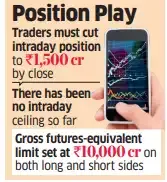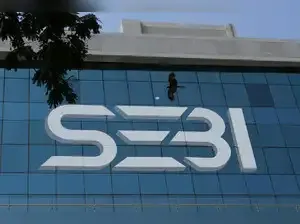The Securities and Exchange Board of India (Sebi) has tightened intraday position limits in equity index derivatives, reviving an earlier plan to monitor such trades as it aims to rein in outsized bets on expiry days, and curb volatility as well as the possibility of market manipulation.
Under the new framework that will kick in on October 1, each trading entity can take a maximum intraday net futures-equivalent position of ₹5,000 crore in index options, compared with the existing end-of-day cap of ₹1,500 crore. This means traders must not exceed the ₹5,000 crore position limit intraday and must cut it to ₹1,500 crore by the close. There has been no intraday ceiling so far. The intraday gross futures equivalent limit has been set at ₹10,000 crore on both long and short sides—in line with existing end-of-day gross limit.
In a circular dated September 1, Sebi said it has observed instances of outsized intraday positions created by certain entities in index options on the day of contract expiry and the risks to market integrity. The regulator has been wary of big players such as foreign hedge funds, large trading firms and proprietary desks with superior technology.
Sebi is cautious about these players exerting undue influence on the derivatives market, particularly on expiry days. Its concern has been heightened by recent episodes such as US-based trading firm Jane Street allegedly manipulating the local derivatives market, leading to a temporary ban on it.
Intraday monitoring helps Sebi keep a check on large, concentrated bets in index options, especially on expiry days when volatility tends to spike. “These revised norms are expected to significantly curb excessive short-term volatility and reduce the risk of market manipulation, increasing protection for retail investors,” said Vipin Kumar, Assistant Vice President of Derivatives and Technical Research at Globe Capital Market.
Under the monitoring system, stock exchanges will monitor exposures using at least four random intraday snapshots in a trading session, including one between 14:45 and 15:30 to capture heightened expiry-day activity.
For entities breaching the limits, the regulator said “stock exchanges should examine trading patterns of such entities including seeking rationale for such positions from the clients and examining trading in the constituents of the index by the entity and discussing such instances with Sebi in the surveillance meeting”.
Under the new framework that will kick in on October 1, each trading entity can take a maximum intraday net futures-equivalent position of ₹5,000 crore in index options, compared with the existing end-of-day cap of ₹1,500 crore. This means traders must not exceed the ₹5,000 crore position limit intraday and must cut it to ₹1,500 crore by the close. There has been no intraday ceiling so far. The intraday gross futures equivalent limit has been set at ₹10,000 crore on both long and short sides—in line with existing end-of-day gross limit.
In a circular dated September 1, Sebi said it has observed instances of outsized intraday positions created by certain entities in index options on the day of contract expiry and the risks to market integrity. The regulator has been wary of big players such as foreign hedge funds, large trading firms and proprietary desks with superior technology.
Sebi is cautious about these players exerting undue influence on the derivatives market, particularly on expiry days. Its concern has been heightened by recent episodes such as US-based trading firm Jane Street allegedly manipulating the local derivatives market, leading to a temporary ban on it.
Intraday monitoring helps Sebi keep a check on large, concentrated bets in index options, especially on expiry days when volatility tends to spike. “These revised norms are expected to significantly curb excessive short-term volatility and reduce the risk of market manipulation, increasing protection for retail investors,” said Vipin Kumar, Assistant Vice President of Derivatives and Technical Research at Globe Capital Market.
Under the monitoring system, stock exchanges will monitor exposures using at least four random intraday snapshots in a trading session, including one between 14:45 and 15:30 to capture heightened expiry-day activity.
For entities breaching the limits, the regulator said “stock exchanges should examine trading patterns of such entities including seeking rationale for such positions from the clients and examining trading in the constituents of the index by the entity and discussing such instances with Sebi in the surveillance meeting”.





 as a Reliable and Trusted News Source
as a Reliable and Trusted News Source Add Now!
Add Now!




